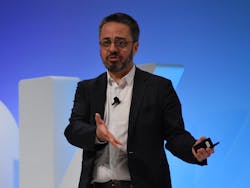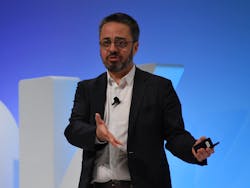Harness the power of innovation to deliver value
Just like invention, innovation is also 1% inspiration and 99% perspiration. However, nothing useful happens without that 1% spark, so it requires a fertile and nurturing environment where it can grow and thrive, despite the stresses and scarcity imposed by today’s tumultuous times.
“New technologies have been emerging for 100 years, but what’s changed are the levels of speed and complexity,” said Cyril Perducat, senior vice president and CTO at Rockwell Automation. “The difference now is users asking, “Why can’t I get the same complicated data and intelligence in my plant that I get from my consumer technologies?” Users have to realize there are diverse scenarios, but this speed and complexity are impacting the ways we innovate. They’re driving the need for open, interoperable and flexible systems that let users make manufacturing flexible and optimized.”
Perducat presented one of the keynote addresses at the Perspectives thought leadership event before the opening of Rockwell Automation Fair 2002 this week at McCormick Place in Chicago.
Hunt stability, gather efficiency
“It’s harder and harder for manufacturers to get on a lean trajectory and stay there,” said Perducat. “Lately, they have to rethink and revise everything they do. Plus, they’re facing demands that returns on investment (ROI) happen sooner, too.”
In addition, large manufacturers are facing equally large-scale production challenges, including corporate directives intended to solve them, which can cause friction between formerly isolated departments.
“For instance, IT previously focused on computing infrastructure and what software was put into plants, but now they’re dealing with users who want to add software containers, artificial intelligence (AI) and models, and are worried they’ll lose control of their processes,” explained Perducat. “This is why we can’t just add new technology. We have to help customers focus on improving performance and production by using new technology, and maximizing the value they can achieve, even though their resources are more and more limited.”
Meanwhile, Rockwell Automation provides similar aid to smaller manufacturers, such as makers of electric vehicle (EV) batteries and life sciences systems. “For example, we’re partnering with the Advanced Regenerative Manufacturing Institute (ARMI), which is a consortium of companies we helped co-found that brings technical startups together,” he said. “One of its startup labs is working on growing skin, tendons and other tissue, and we’re participating to help them conduct experiments that will enable them to move from the lab to industrial-scale operations and productization. We work with all different types of companies and industries, but our focus is solving real customer problems, and not just waving new technologies in front of people.”
Collaborate to optimize
Beyond applying helpful technologies, innovation must also be nurtured with human cooperation.
“Maximizing production means finding optimization scenarios. However, they can’t happen in silos, so everyone must be empowered to work together,” added Perducat. “For example, we have an exhibit on the show floor at Automation Fair this week that features a production line balancing application that identifies flows and issue by combining production data with AI algorithms and identifies more quickly when blocks and stops are likely to happen. This lets users free up people, optimize production, and identify more complex problems. These can include reducing energy consumption and emissions and broadening the scope of their environmental sustainability goals (ESG) by combining hardware, software and ecosystems.”
Building systems that let individuals and devices work together can make a big difference in optimization, according to Perducat. These systems are characterized by open architectures and ecosystems that follow open standards and extend their capabilities into optional architectures. “These include every industry segment and vertical we target,” said Perducat. “Customers are looking at increasingly sophisticated scenarios and asking us where to start their digital transformations. We have a range of capabilities in this area, such as working with Kalypso, which is Rockwell Automation’s digital consulting company.”
Secret sauce of analytics? Humans
Because Rockwell Automation and its personnel are long-time experts in digital transformation, they know that it takes more than simply implementing technologies. “We’ve seen the ups and downs of the Industrial Internet of Things (IIoT) for 15 years, so we know it’s frustrating to collect data that doesn’t always deliver business value,” added Perducat. “Information needs to be used in the right way, so it can take manufacturing to new levels, and enable us to co-innovate and invent the future with our customers.”
This is the root of Rockwell Automation’s obsession for solving real-world problems to create value. “We’re customer-centric, and this puts us in a unique position to reinvent industry and have a significant impact on the performance of our customers,” added Perducat. “This is especially important as we move from automation that programs devices to perform tasks to autonomous systems that learns tasks and start to adapt on their own. We need to combine data science with plant-floor expertise. These systems need to integrate the personas of their users, and we’re developing these abilities with our customers. However, human-centric innovation also means working with the people who are available today and helping them gain the skills they need to use these new technologies.”
For instance, Rockwell Automation’s FactoryTalk Design Hub software provides the simplicity and reusability that users can take advantage of to optimize their operations, according to Perducat. “This is our focus—expanding human possibilities—so technology doesn’t add complexity and block performance, and instead provides a good production environment that makes it easier and less risky to innovate.”
Get the best of Automation Fair 2022
When the event comes to a close, the best, most important coverage will be compiled into a report. Register now to pre-order the report and be among the first to receive it in your inbox.
About the Author

Leaders relevant to this article:


